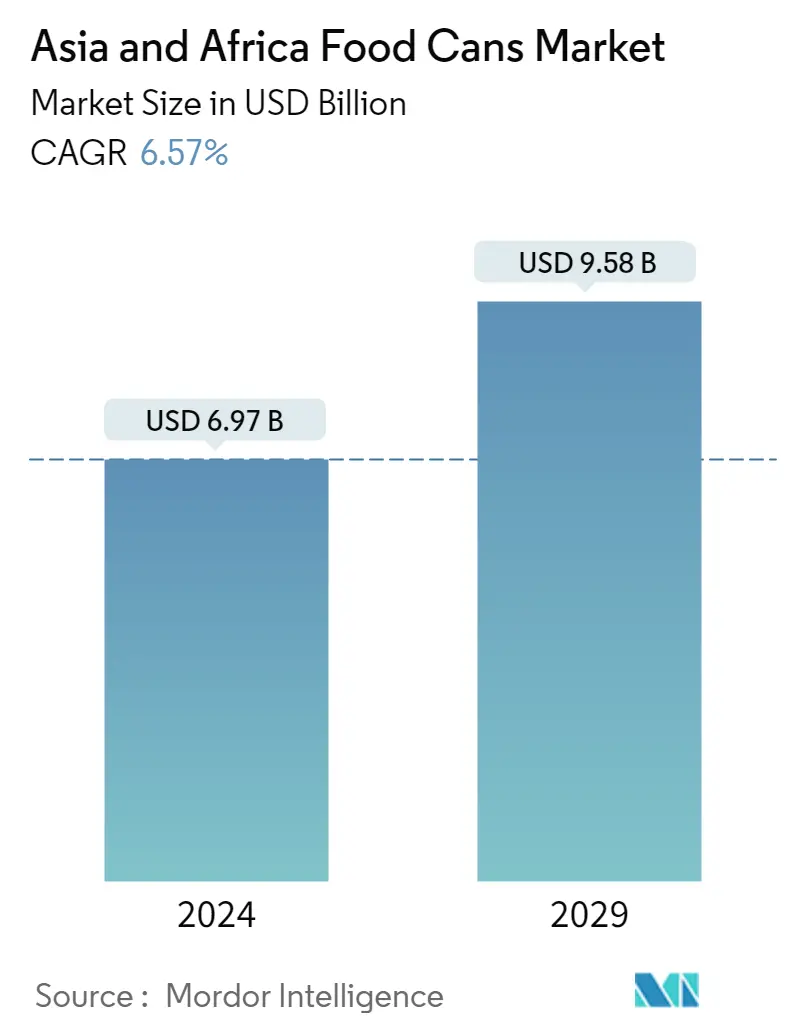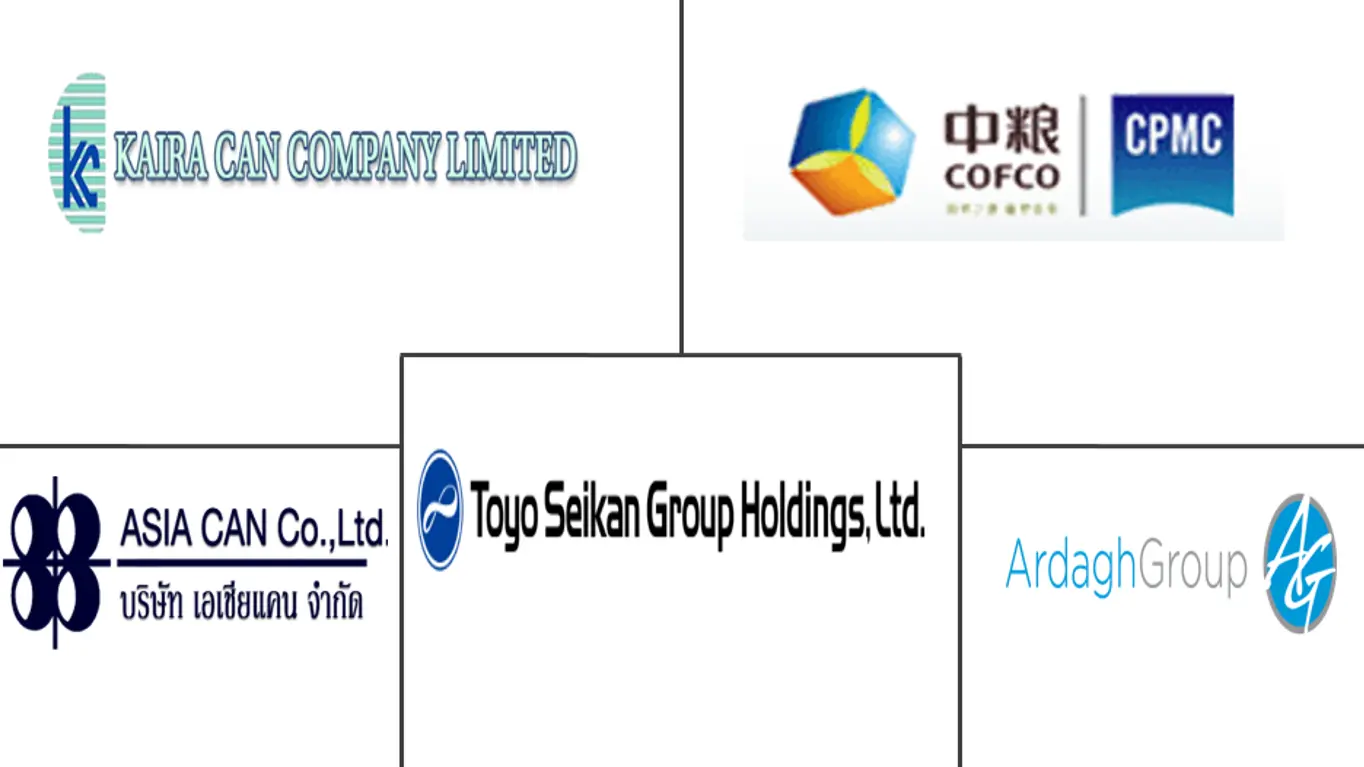Market Size of Asia and Africa Food Cans Industry

| Study Period | 2019 - 2029 |
| Base Year For Estimation | 2023 |
| Market Size (2024) | USD 6.97 Billion |
| Market Size (2029) | USD 9.58 Billion |
| CAGR (2024 - 2029) | 6.57 % |
| Market Concentration | Medium |
Major Players
*Disclaimer: Major Players sorted in no particular order |
Asia & Africa Food Cans Market Analysis
The Asia and Africa Food Cans Market size is estimated at USD 6.97 billion in 2024, and is expected to reach USD 9.58 billion by 2029, growing at a CAGR of 6.57% during the forecast period (2024-2029).
COVID-19 has brought a slew of changes to food consumption. Food and grocery purchase patterns highlighted the changing consumer preferences; shelf-stable foods and canned goods were positioned on top of the grocery shopping list. Moreover, newer products were aligned to have immune system boosting ingredients and nutritional aspects. Frozen foods, among Asian consumers amid the COVID-19 pandemic, garnered growth during lockdowns and tightening economics.
- The excellent preservative properties and structural integrity of the metal cans, offering higher shelf life, have resulted in the high usage of metal cans in the food packaging industry across Asia and Africa. Packaged and convenience foods have become a staple diet for many consumers, owing to their hectic lifestyles and work schedules. For instance, according to the Population Reference Bureau, in 2019, the degree of urbanization (percentage of the urban population in total population) across the world was around 54%.
- According to IIED, across the Asian counterparts, the percentage of the world's urban population living in the region was estimated at 53.9% in 2020. Also, Africa is projected to have the fastest urban growth rate in the world, i.e., by 2050, African cities may be home to an additional 950 million people.
- Metal industries in the respective regions demonstrate a net flourishing trend. In Africa, between ZAR 100 million and ZAR 200 million per year is expected to flow into the scrap metals and recycling industry due to the conversion from tin-plated steel cans to aluminum cans. Also, the industry may provide an additional 2,000-3,000 people a source of income from collecting and selling used cans, as per a reputed beverage can manufacturer, Nampak Bevcan.
- Asian trends are mixed with Southeast Asia's growth. Multiple manufacturers from China and Japan have expanded their footprint in the region. For instance, via its Project 2020+, Showa Aluminum Can Corporation has focused on the growth acceleration of its business in the medium-term by targeting Southeast Asia.
- Then, as of October 2020, multiple large steel projects located in Southeast Asia were underpinned by Chinese investment. At the same time, Southeast Asia reportedly gained attention as more food companies shifted away from plastic containers for more recyclable cans. UACJ Corporation, a Tokyo-based company, is expected to boost the output capacity of aluminum sheets at its Southeast Asian plants by 2021.
Asia & Africa Food Cans Industry Segmentation
The food can is a container for distributing or storing processed food, seafood, fish, etc. It is composed of thin metal, which is prominently gaining popularity due to its growing use in food packaging. Changing lifestyles, growing canned food requirements, and the rising need for processed foods are marking the growth of this market. The market is segmented by material, can type, and application.
| Material | |
| Aluminum Cans | |
| Steel/Tin Cans |
| Can Type | |
| 2-piece | |
| 3-piece |
| Application | |
| Fish and Seafood | |
| Fruits and Vegetables | |
| Processed Food | |
| Pet Food | |
| Other Applications |
| Geography | ||||||
| ||||||
|
Asia and Africa Food Cans Market Size Summary
The Asia and Africa food cans market is experiencing significant growth, driven by changing consumer preferences and the increasing demand for shelf-stable foods. The COVID-19 pandemic has accelerated this trend, as consumers have prioritized convenience and long-lasting food options. Metal cans, known for their excellent preservative properties and structural integrity, are becoming the preferred choice for food packaging in these regions. This shift is further supported by the urbanization trends in Asia and Africa, where busy lifestyles are leading to a higher consumption of packaged and convenience foods. The market is also witnessing a transition from tin-plated steel cans to aluminum cans, which is expected to boost the recycling industry and create additional income opportunities in Africa.
In addition to the growing demand for canned foods, the market is benefiting from the substantial production of fruits and vegetables in countries like China and India, which provides ample raw materials for canning. The shift towards canned foods is also influenced by economic factors, as canned fruits and vegetables offer a cost-effective alternative to fresh or frozen options without compromising nutrition. Government initiatives in countries like South Korea are promoting the reduction of plastic waste and encouraging the use of recyclable materials such as steel and aluminum, further driving the demand for food cans. The market is characterized by moderate competitiveness, with key players focusing on innovation and strategic partnerships to enhance their market presence.
Asia and Africa Food Cans Market Size - Table of Contents
-
1. MARKET DYNAMICS
-
1.1 Market Overview
-
1.2 Market Drivers
-
1.2.1 High Recyclable Score of Metal Cans over Alternatives
-
1.2.2 Demand for Canned Foods Driven by Cost and Convenience-related Advantages
-
1.2.3 Product Innovations Leading to Increased Shelf Life
-
-
1.3 Market Challenges
-
1.3.1 Plastic Remains a Highly Credible Alternative in the Regions
-
-
1.4 Market Opportunities
-
1.5 Industry Attractiveness - Porter's Five Forces Analysis
-
1.5.1 Bargaining Power of Suppliers
-
1.5.2 Bargaining Power of Consumers
-
1.5.3 Threat of New Entrants
-
1.5.4 Intensity of Competitive Rivalry
-
1.5.5 Threat of Substitutes
-
-
1.6 Industry Supply Chain Analysis
-
1.7 Impact of COVID-19 on the Market
-
-
2. Market Segmentation
-
2.1 Material
-
2.1.1 Aluminum Cans
-
2.1.2 Steel/Tin Cans
-
-
2.2 Can Type
-
2.2.1 2-piece
-
2.2.2 3-piece
-
-
2.3 Application
-
2.3.1 Fish and Seafood
-
2.3.2 Fruits and Vegetables
-
2.3.3 Processed Food
-
2.3.4 Pet Food
-
2.3.5 Other Applications
-
-
2.4 Geography
-
2.4.1 Asia
-
2.4.1.1 China
-
2.4.1.2 India
-
2.4.1.3 South Korea
-
2.4.1.4 Southeast Asia
-
-
2.4.2 Africa
-
2.4.2.1 South Africa
-
-
-
Asia and Africa Food Cans Market Size FAQs
How big is the Asia and Africa Food Cans Market?
The Asia and Africa Food Cans Market size is expected to reach USD 6.97 billion in 2024 and grow at a CAGR of 6.57% to reach USD 9.58 billion by 2029.
What is the current Asia and Africa Food Cans Market size?
In 2024, the Asia and Africa Food Cans Market size is expected to reach USD 6.97 billion.

